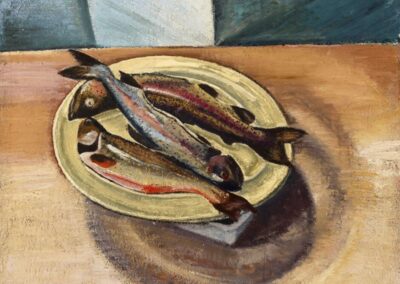Our next Artist You Need To Know is Paraskeva Clark (1898 – 1986).
A Russian – Canadian painter, Paraskeva Clark was a member of the Canadian Group of Painters (1936); the Canadian Society of Painters in Water Colour (1937); Canadian Society of Graphic Art (1938, resigned 1940); the Ontario Society of Artists (1954), and the Royal Canadian Academy (Associate, 1956; Academician, 1966).
Her work is often political as she believed that “an artist must act as a witness to class struggle and other societal issues” and during her most productive periods “she was one of only a few Canadian painters whose work reflected her political convictions.” (from here)
Clark (née Plistik) was born in St. Petersburg in pre revolutionary Russia and took evening classes at the Petrograd Academy of Fine Arts as a child. In 1916 she was studying under Savely Seidenberg. After the Russian Revolution, she began to attend the Free Studios (from 1918-1921) where the painters Vasily Shukhayev [also known as Vasily Shukhaev] and Kuzma Petrov-Vodkin significantly shaped her early experience as a painter.
Like many Russians of her generation, Clark left the USSR for Paris (in 1923), where she met and married a Canadian, Philip Clark: in 1931 they would relocate to Toronto, and Clark found herself in the company of many of the major figures in the Canadian painting establishment. In 1932 she had exhibited a self-portrait at the Royal Canadian Academy annual exhibition.
Clark was as engaged with ideas as she was painting, and drew on her knowledge and experience in giving several important lectures on Soviet art at the Art Gallery of Ontario. As World War II broke out, Clark was appointed by the National Gallery of Canada to record the activities of the Women’s Divisions of the Armed Forces, and these are among some of her more engaging artworks.
She participated in many group shows and between 1951 and 1956, she held four large solo shows at the New Laing Gallery (1959), the University of Toronto (1952), MacDonald College, McGill University (1956) and Hart House, University of Toronto (1956). Her work is owned by the National Gallery of Canada, Hart House, the Art Gallery of Ontario, and many private collectors.” (from here)
But you may be familiar with her work due to her inclusion in a fine current exhibition titled Uninvited: Canadian Women Artists in the Modern Movement (this was developed by the McMichael Canadian Art Collection, Kleinburg, ON in 2022 and will travel to the Glenbow Museum, Calgary, Alberta and the Winnipeg Art Gallery, Winnipeg, Manitoba).(from AWARE)
Some accounts of Clark’s time in Toronto have described her as a forceful and strongly opinionated personality: but this is something that was essential in terms of her contribution to Canadian art and reflect how she was a more accurate chronicler of history than some of her Canadian contemporaries. From Christine Boyanoski: “When Paraskeva Clark immigrated to Canada in 1931, she brought fresh eyes with which to observe the Canadian scene. Her political leanings equipped her to be a passionate spokesperson for socially engaged art.”
There was also a film produced in 1982 by the National Film Board of Canada titled Portrait of the Artist — As an Old Lady. That can be watched here. She is described in this cinematic work as an “artist, socialist, feminist, [and] is her own woman at her own cost…an irascible and oftentimes touching artist whose work has won her a place in exhibitions and private collections…because her canvases reflect a strong social conscience, she had to struggle hard to earn a place in the nation’s ultra-conservative galleries.”
Clark once observed that “the process of the growth of a nation’s art is the process of the growth of the soul of a nation, of the conscience of that nation.” Her artwork and legacy are intrinsic to this notion.
The Canadian Art Institute (one of the finest resources you will find online about both contemporary and historical Canadian art) has a plethora of information on Clark: that can be enjoyed here. They have many more of her works and more information on why she is an artist whose work you need to know.



























